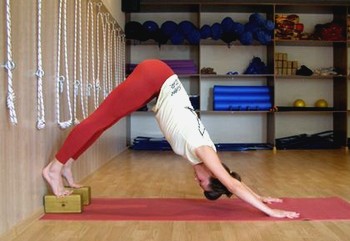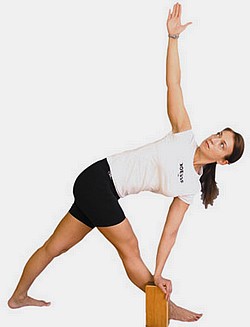The Purpose of Yoga Blocks
Yoga blocks belong to so called ‘yoga props’ – helpful things to make the performance of yoga poses easier for beginners.
These blocks can be used in almost every asana; basically the play two main roles:
- Provide additional support
- “Extend” your arms – similar to yoga straps.
For example, in some standing poses like the Triangle pose (Trikonasana), when you cannot reach the floor due to the lack of flexibility, you can have a block on the floor to place your palm on; this is a good support and the asana will be done properly.
Often blocks are used when a person has some kind of injury, but it is not always like that. Often blocks help to increase your current flexibility, add stability to standing poses and help to increase the time of holding a pose. They can even help to open the chest in Ujjayi pranayama.
Blocks are usually made of wood, cork or foam. The material may influence the price of the props, but you can always choose what you like.
How to Do Yoga Poses With a Block
There are many poses (almost all of them) you can do using a block. Let’s start with a popular and rather simple asana – the Downward-Facing Dog Pose or Adho Mukha Svanasana.
If you have difficulties stretching your back and hamstrings, you can try putting a block under your feet and against the wall, as shown on the image below.
 Another good example is the Triangle pose. If you are not very flexible, you can still do the pose properly by using a block. See the picture below how to do it.
Another good example is the Triangle pose. If you are not very flexible, you can still do the pose properly by using a block. See the picture below how to do it.
The most common are Iyengar yoga poses with blocks – Iyengar school uses a lot of various props to let all types of students do the variety of poses including those they would never be able to do properly right from the start.
Yoga Wheel Pose With Blocks
The Wheel Pose or Chakrasana is not actually a pose for beginners; yet when you start learning it, the most difficult thing is, in my opinion, to reach the floor with your hands. Even when you use a strap or a kind of support to hold your waist, reaching the floor is still a difficult task, and here comes the blocks! Put a block under each arm (or against each arm) and when you are doing the Wheel pose, slowly place your arms over the block. Once your palms are stable, relax your back muscles, inhale and open your chest. Hold the pose as long as it’s comfortable for you, breathing normally. Then you can either return to a standing position (if you are using a support belts or ropes), or you can slowly lower your body to the ground; once your pelvis reaches the floor, remove the hands from the block, lie on your back and rest for a while.
Yoga Fish Pose With Blocks
The main problem with the Fish pose or Matsyasana is the chest opening. The majority of people have a stiff chest, so doing this pose maybe difficult in the beginning. Putting a block right under your upper back will help to open the chest more than usual because of two things:
- There will be support for it
- The chest and upper back muscles will be relaxed due to the said support provided by the block
Normally, you arch your upper back by the use of the muscles, but when your chest and shoulders are stiff, it may be pretty difficult. A block provides you with the needed support and relaxation.
The same way you can use different restorative yoga poses with blocks; the most vivid example here is Viparita Karani Mudra or Upside Down Seal or Legs-Up-the-Wall Pose. Originally the pose is performed by holding the pelvis and the lower back by the hands with elbows on the floor. But for a beginner it may be difficult, because after a minute or two the hands go numb and elbows start aching. But you can use a block instead of your hands: put the one under your pelvis or the lower back (if it is big enough) and rest your legs against the wall; the neck is on the floor and relaxed; your arms are at the body’s sides. Relax and breathe normally. Remain in the pose for 3-5 minutes then do the Corpse pose or Shavasana for half of the time you spent in Viparita Karani.
I hope you got the idea how to do yoga poses with blocks and straps. I mean the straps are used in the similar way – to give you an additional stretching and support.

